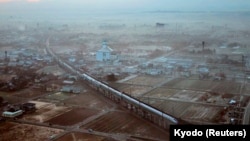Japanese railway company, Tokyu, says it now uses only renewable energy to power its train operations. That means Tokyu’s huge network of train lines in and around Tokyo do not produce any carbon dioxide emissions.
The change took place April 1.
Tokyu employs 3,855 people and connects Tokyo with the nearby city of Yokohama. It has more than 100 kilometers of railway tracks serving 2.2 million people a day.
It is the first railroad operator in Japan to have reached the goal of zero carbon emissions. It says the carbon dioxide reduction is equal to the yearly average emissions of 56,000 Japanese households.
Nicholas Little is director of railway education at Michigan State University. He praised Tokyu for supporting renewable energy. But he noted it is also important to improve ways of creating renewable energy.
“...The bigger impacts come from increasing electricity generation from renewable sources,” Little said. “The long-term battle is to increase production of renewable electricity.”
So, is Tokyu’s move to renewables just a campaign for good publicity? Or, is the company moving in the right direction for the environment?
There is no simple answer says one expert. Ryo Takagi is a professor at Kogakuin University and specialist in electric railway systems. He says bigger environmental gains would come from changing rural operations from diesel fuel to hydrogen power or switching to electric automobiles.
Tokyu’s action is better than nothing, but Takagi said, “I am not going out of my way to praise it as great….”
Tokyu official Yoshimasa Kitano says the company plans more action toward cleaner operations.
“We don’t see this as reaching our goal but just a start,” Kitano said.
Such steps are critical for Japan, the world’s sixth-biggest carbon polluter. The country has a goal of becoming carbon-neutral by the year 2050.
About 20 percent of Japan’s electricity comes from renewable sources, says Japan’s Institute for Sustainable Energy Policies.
That is far behind New Zealand, for example, where 84 percent of power used comes from renewable energy sources. New Zealand hopes to make that 100 percent by 2035.
The renewable sources driving Tokyu trains include hydropower, geothermal-power, wind power and solar power. That information comes from Tokyo Electric Power Co., the utility that provides the electricity and looks at its energy sourcing.
Since Japan’s 2011 nuclear disaster in Fukushima, the country has shut down most of its nuclear plants and increased use of coal-fired power plants.
Japan aims to have 36 to 38 percent of its energy come from renewable sources by 2030.
I’m Jill Robbins.
The Associated Press reported this story. Ashley Thompson adapted it for VOA Learning English.
____________________________________________________________________
Words in This Story
emissions - n. something sent out or given off
impact - n. a powerful or major influence or effect
average - adj. a number that is calculated by adding quantities together and then dividing the total by the number of quantities
utility - n. a company that provides electricity, water, etc.









